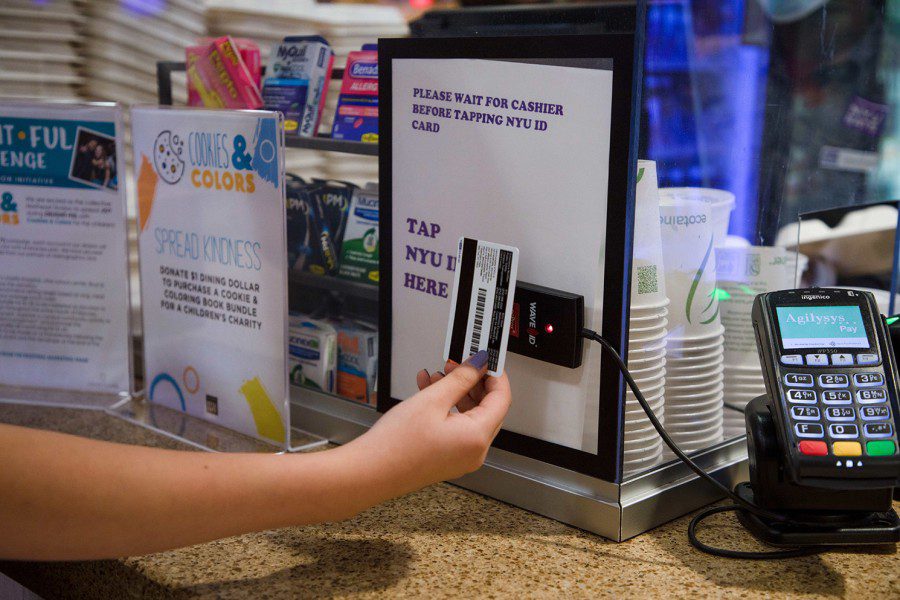Opinion: Meal Plans aren’t useless — you’re just using them wrong
Yes, the Lipton toaster somehow burnt only the left side of my bagel. No, I still won’t get rid of my meal plan.
Although many students complain about NYU’s meal plans, they can be cost-effective when used correctly. (Joshua Becker for WSN)
September 21, 2022
As an incoming first-year, one of the most complicated things that I had to go through was navigating NYU’s meal plan — rivaled only by trying to figure out how to manage the Vax Pass, the Violet Go pass and my ID every time I wanted to enter a building.
Among meal swipes, meal exchanges, Dining Dollars, Grubhub, buffet-style dining halls and à la carte options, it can get pretty confusing. And don’t even get me started on the erratic dining hall hours (I’m looking at you, 18 Below, and your choice to operate for only three hours per day). Maybe this is why you’ll hear several upperclassmen tell you that meal plans aren’t worth it, or at least suggest that you downgrade to one with fewer swipes and more dining dollars.
But before you start spending millions for a convenient dinner on MacDougal Street every night, hear me out. Once you figure out how to apply them, meal plans are worth it, and in most cases, can even save a ton of money.
First, let’s talk about the No. 1 argument against a meal plan: dining hall cash registers say that a meal swipe is worth $15, and no one in their right mind would pay that much for a meal at an NYU dining hall. And to that, I say I agree. However, when you do the math, you’ll realize that when you purchase a meal plan, you’re actually paying less per meal.
For example, the default first-year plan, the 225 Flex, costs $2,806 per semester for 225 meals and 200 Dining Dollars. If you subtract the 200 Dining Dollars since they have a dollar-for-dollar value, then you’re paying $2,606 for 225 meals. This is an average cost of $11.58 per meal, which is much more reasonable. And as the meal plans get bigger and more expensive, their value-for-money increases — 300 Flex Plus only averages $9.92 a meal.
Now, the question becomes how to make the most of every meal, and my answer is: be frugal. Take advantage of Grubhub, where you can often add additional sides that you’d be charged extra in person for (Palladium spring rolls). Instead of a bag of chips, get the side salad that can become a little meal between classes. By getting the right things, you can use leftover tidbits from meal swipes to make an in-dorm pantry.
Additionally, resist the urge to downgrade for more Dining Dollars or use meal swipes on retail locations like Dunkin’. I know it seems like Dining Dollars are more versatile than meal swipes, but they have a dollar-for-dollar value; it’s no different than just paying for the item upfront. Save your Dining Dollars for when you need to purchase something from one of the markets, or when you want an extra little side on your meal. Plus, Dining Dollars carry over per semester, so you don’t need to worry about using them the way you do meal swipes.
Using meal swipes at Peet’s Coffee and Dunkin’ sounds tempting, but that means you’re paying $12 for a coffee and a cold bagel where the butter isn’t even spread on for you. That same meal swipe could get you enough pizza to feed a small army at one of the buffet locations like Downstein or the absolute magic that is Palladium brunch.
The final argument against meal plans comes down to one of taste, and I will concede. Compared to the wonders of New York City food, NYU dining seems mediocre at best and a punishment at worst. However, the dining halls often have accessible, reliable, nutritional and preference-friendly food, something you can’t get from eating dollar pizza every single day. A quick glance at the menus for each day, and WSN’s incredibly helpful dining hall ranking should help you find at least one thing you like.
And after all of that, if you still miraculously have meal swipes left, they don’t have to go to waste. You can take advantage of NYU’s Swipe it Forward program to alleviate the issue of food insecurity for one of the 41% of students that experience it on campus.
There will always be those who use their $12 meal swipes on one drink, and that’s OK — it’s their money. However, these may be the same people who tell you that meal plans aren’t worth it. Take it from me, an inexperienced first-year living in a dorm with no kitchen and severe anxiety about New York’s rising grocery prices — with enough research and Grubhub finagling, NYU’s meal plans can definitely more than make up for their price.
Don’t spend all your Dining Dollars on Starbucks in the first two weeks, and you’ll be fine.
WSN’s Opinion section strives to publish ideas worth discussing. The views presented in the Opinion section are solely the views of the writer.
Contact Naisha Roy at [email protected].

























































































































































